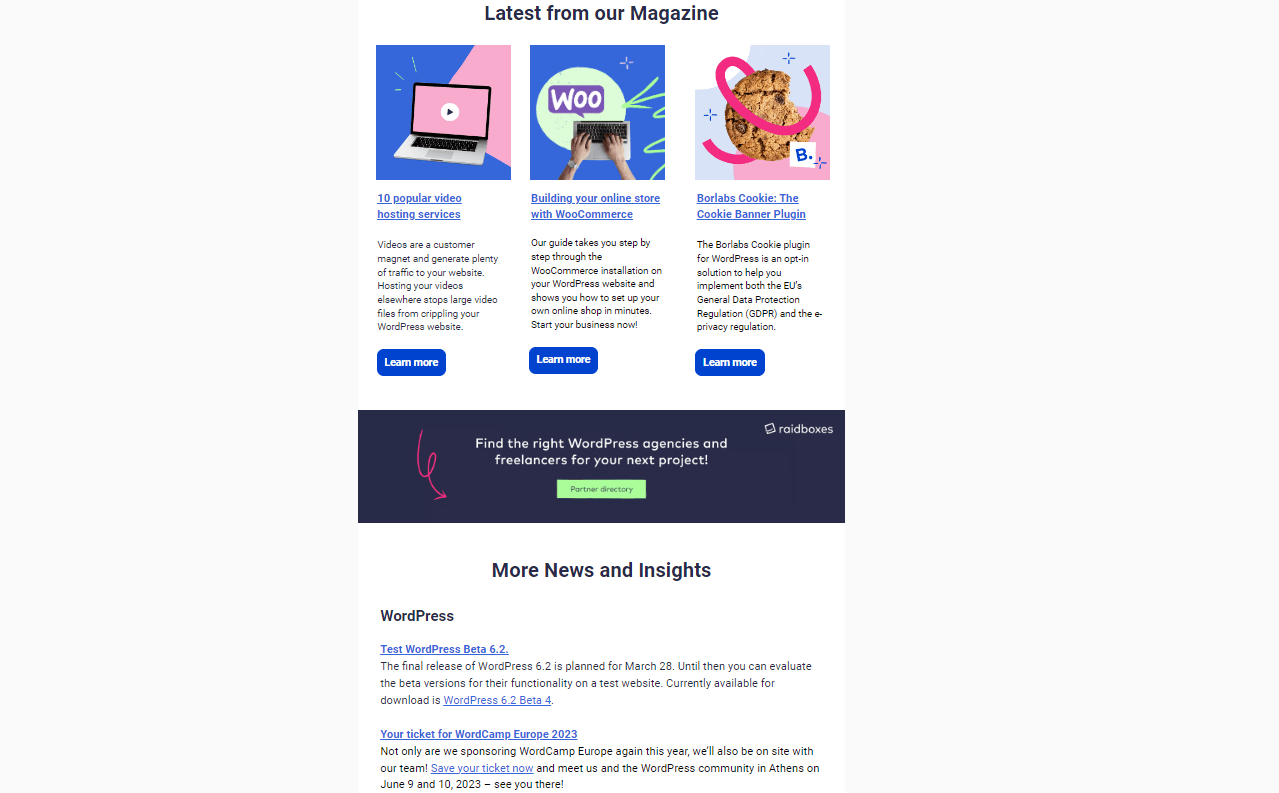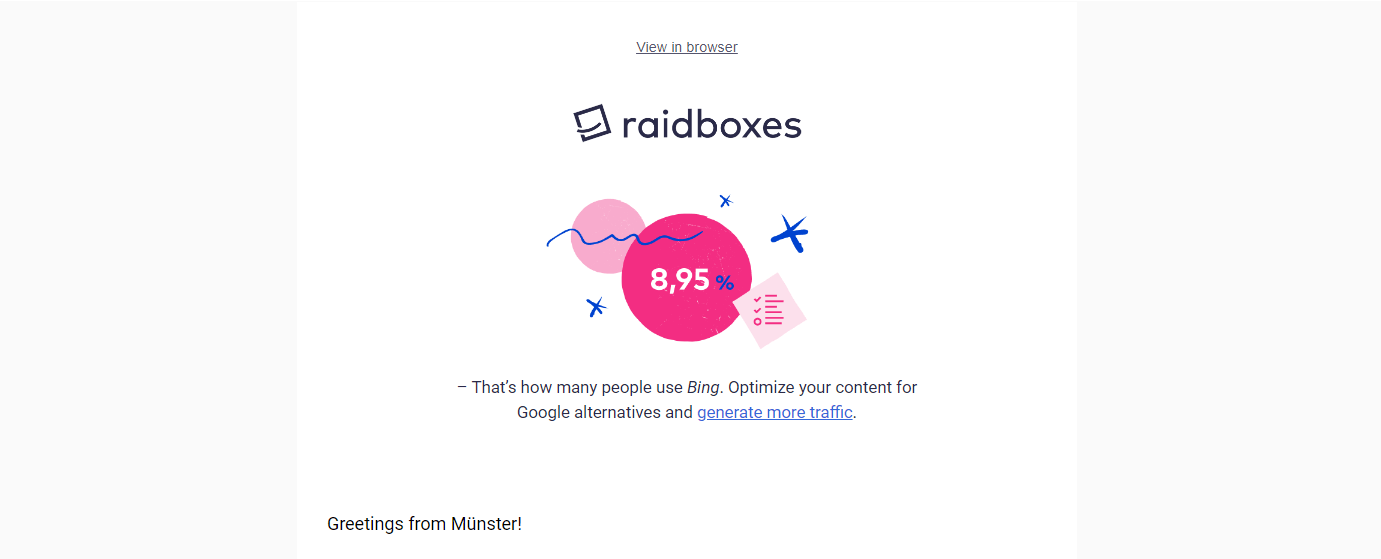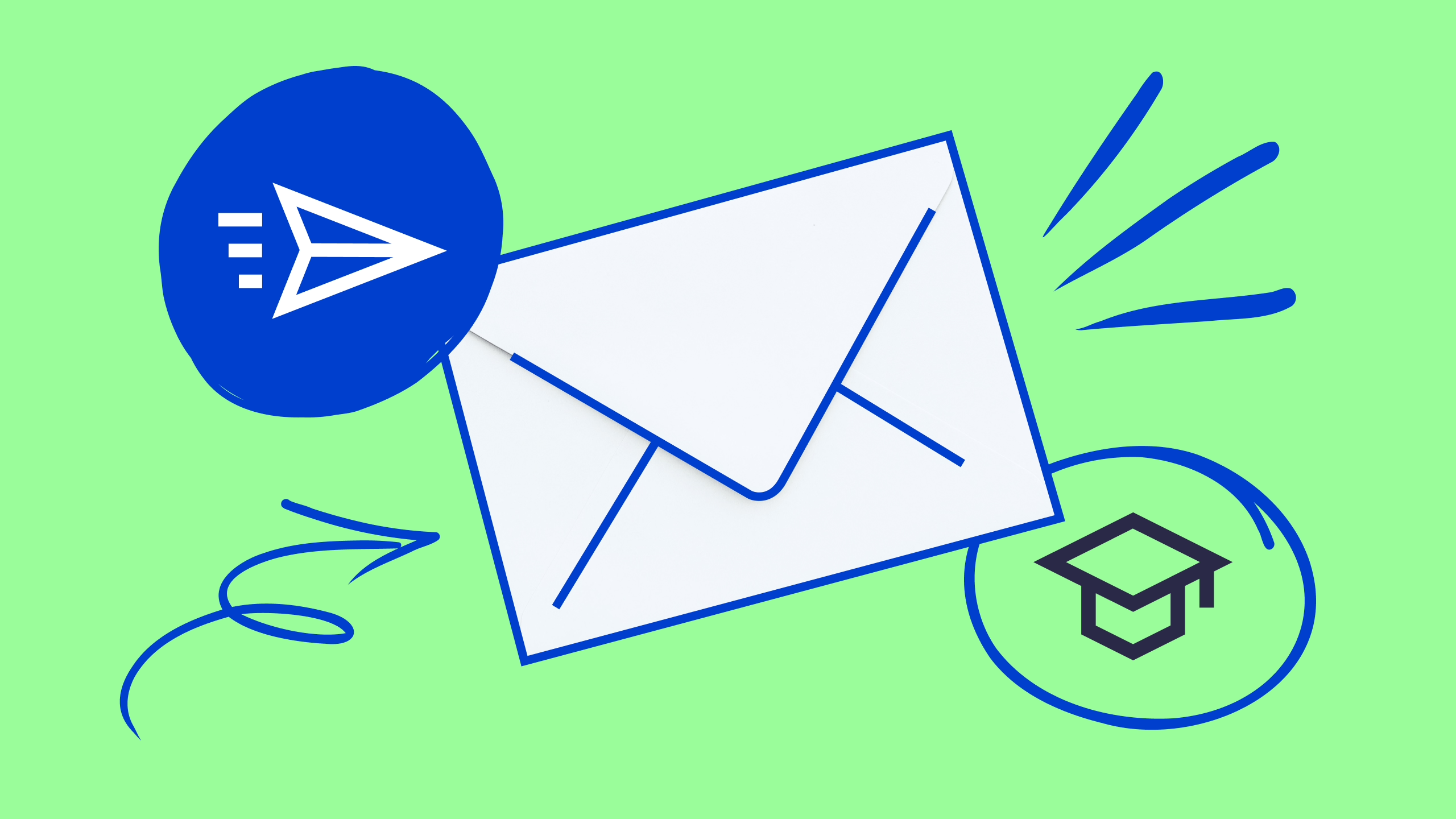Newsletters are pushed at you almost everywhere these days – often within the first few seconds of your first visit. If you want to assert yourself in this information overload of email marketing, you absolutely need a good content concept. In this article, we’ll give you some ideas. We’ll also explain how to find the right frequency and design for your emails.
This is the second part of a series of articles on the topic of email marketing. You can find the first one on the basics of email marketing here.
Good email marketing is rarer than it should be
I subscribe to newsletters from companies and organisations purely out of professional interest. I am simply curious to see what I can learn from them. The results often fall into one of two categories:
- The company has more or less forgotten that it uses email marketing at all. I never or very irregularly receive a newsletter. Perhaps the person responsible is overloaded with other tasks or no one is responsible at all?
- On the contrary, I’m inundated with emails full of special offers and other sales promotions – which rarely have anything to do with my actual interests. Motto: A lot helps a lot. Just send everything out!
Interestingly, this applies to organisations of all sizes, with very different target groups and from various industries. However, the larger the organisation, the more likely I am to be overwhelmed by too many emails.
Such a flood is a particular problem if the emails are also irrelevant.
An example: I have just bought something and soon afterwards I receive an advertising email with the excited announcement that there is a 20 per cent discount on everything (except pet food). Great! Thank you for this hint that I have once again spent too much money …
In general: unfortunately, “email marketing” is too often equated with “advertising newsletters”. And because the costs for mass mailing are so low, the pressure is on. The surprise is then great when the final result looks mixed.
In this article, I would like to show you how to do it better. In the previous part of this series, I already showed you how diverse email marketing can be. It’s not just about promotional messages! Newsletters, email series and even transactional emails can fulfil different tasks. They can make new prospects aware of you, make existing customers more satisfied and generally ensure that you are recognisable and memorable with your offers.
But how exactly do you do that?
Subscribe to the Raidboxes newsletter!
We share the latest WordPress insights, business tips, and more with you once a month.
"*" indicates required fields
1. find the right content
In the spirit of content marketing and an overarching content strategy, your communication should be about maintaining relationships and building a community. This is too often forgotten or not taken seriously.
Many companies tend to think in the short term and this is not surprising: we humans tend to prefer a small reward to a big reward if the small reward is immediate. This is even more true if the later, larger reward is not guaranteed.
This is why companies primarily want to increase their figures here and now and do not think so much about their potential success tomorrow and the day after tomorrow. How the targets set can be achieved next year or in five years’ time plays only a subordinate role at the moment.
Especially as a freelancer or smaller agency, this shouldn’t happen to you. You can (also) use email to gain trust, build a good reputation and strengthen the loyalty of existing customers.
For example, think of an email concept that also deals with other topics that might interest your readership. Examples of this:
- General news and trends from your industry.
- Insights into your work behind the scenes.
- Short texts with a personal touch – similar to a blog or a column.
- Useful articles that explain terms or introduce an interesting new tool, for example.
- Small instructions as well as tips and tricks.
As an illustrative example, I already recommended the monthly WordPress newsletter from Raidboxes in the first part of this article series.
As a freelancer or agency, you have the great advantage of being very close to your customers. You can utilise this perfectly in this case. You will hear questions or be confronted with problems from your customers. So you already know first-hand what moves your target group. Large companies have to commission expensive and time-consuming surveys to do this.
If you actively engage in content marketing and social media marketing, you will have content that you can utilise twice. Or vice versa: you write something for the newsletter that can also be used elsewhere.

The trend towards paid newsletters shows just how popular and valuable such emails can be. This works particularly well when they provide a clearly defined target group with insights and tips that they cannot easily find elsewhere. Basically, it is comparable to the role played by trade magazines, only smaller and more focussed.
Think about an e-mail offer that is primarily informative, interesting and relevant. Use it only occasionally for advertising on your own behalf.
At the same time, this doesn’t mean that you shouldn’t talk about yourself and your offers at all. That would be just as extreme and unhelpful. If you have an exciting new product that is particularly relevant for your readership, don’t be afraid to include it in the newsletter or send out a separate email. Just make sure you limit yourself to the most important moments and at the same time reward your readership: they may be the first to get access or a special offer price. The advertising is no longer (just) perceived as advertising, but as a monetary benefit, so to speak. Such “goodies” can even be a reason to stay on your e-mail distribution list.
In terms of content, you can also consider a mix of automated and manually created content. There may be a section that lists the five latest offers, but also a self-written editorial.
2. the perfect frequency for your email marketing
How often should you get in touch with your recipients? Unfortunately, as is so often the case, there is no clear answer to this question.
The frequency formula
The frequency of your messages should be based on the one hand on the habits and expectations of your readership and on the other hand on your possibilities.
You don’t have to send out a daily newsletter. Even weekly is not necessary. But it shouldn’t be less than once a month, otherwise you’ll be forgotten. Some recipients will then no longer know why they are receiving this email and, in the worst case, will mark it as spam.
If you are completely new to this area, start small. Media offerings grow over time. It’s perfectly fine to send an email with three content elements every fortnight or so. Relevance is much more important! Class instead of mass.
Sometimes newsletter senders leave it up to their readers to decide how often they want to receive information. This can be a good idea, but it can also overwhelm users. Because one basic rule is: make it as easy as possible for interested parties to sign up to your mailing list.
You could instead offer another frequency as an alternative if someone wants to unsubscribe from the mailing list.
Content marketing for advanced users: The 6 most important levers
Discover how to optimize your content marketing to reach the right audience, build trust, and achieve long-term success.
This way, you won’t lose readers who are generally interested in your content but simply receive too many emails.
3. the thing with the design of emails
Another important element is the visual presentation of the emails. Pure text newsletters are hardly to be found today. Instead, similar to websites, photos, graphics, colours and fonts are used.
There are many good arguments in favour of this. For example, you probably want your corporate identity to be reflected in the layout. In addition, graphics and photos attract more attention and can support an emotional appeal.
The biggest problem is that the landscape of email clients is unfortunately extremely fragmented. In other words: while there is a fairly large foundation of generally available design options for browsers, this is unfortunately not the case for email. Gmail in the browser, Outlook on the PC or the Mail app on the iPhone can display the same email in very different ways. Sometimes so differently that it is barely usable.
This is another reason why it has become common practice to include a link to the web version of the newsletter right at the beginning of the e-mail.

Another hurdle is the pictures. If you want to make sure that they are displayed, you could send them as an attachment. However, you should avoid this in all but a few exceptional cases. The email will quickly become too large and messages with attachments will be scrutinised more closely by spam and malware filters. This can lead to it not being delivered at all.
For this reason, images are usually downloaded from the network as soon as the email is opened. However, this only works if the recipient is also online and allows images.
There are good reasons for switching off images in emails or only sharing them when necessary. Some people may be travelling and don’t want to overuse the data package in their mobile phone tariff. For others, it is a question of privacy. In companies in particular, images in emails may be switched off for security reasons. Unfortunately, there are many other reasons why loading images can go wrong.
You must therefore assume that your elaborately designed email will not reach your readers at all. In addition to the aforementioned link to the web version, it is therefore also a good idea to add alt texts to your images. This will also help anyone who uses a screen reader.
Conclusion to your email marketing concept
Ultimately, you should spend most of your time and energy on the content concept. This is the crucial element. The following applies: If you can explain exactly why people should subscribe to your newsletter, you will also attract new readers.
“Keep up to date with our offers” is definitely no longer enough in today’s information overload.
In the next article in this series, I’ll go into more detail about how to get people excited about your newsletter and what you need to do to actually reach them.
Your questions about e-mail marketing concepts
What questions do you have about email marketing concepts? We look forward to your comments. For more insights on WordPress, web design or online business, follow Raidboxes on Facebook or LinkedIn – or subscribe to our newsletter.

Leave a Reply